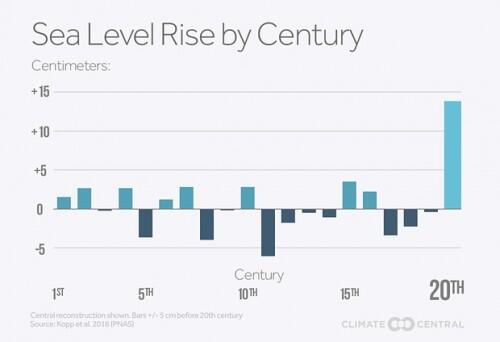Rising sea levels are putting increasing pressure on US coastal cities, with a new analysis showing that human-driven climate change is to blame for three-quarters of the coastal flooding events over the past decade.
The Climate Central research shows that coastal flooding days have more than doubled in the US since the 1980s, the primary drivers of which have been the warming of the atmosphere and oceans. The findings are based on a separate study, released on Monday, that found the Earth’s seas are rising at a pace unseen in the past 2,800 years.
Between 2005 and 2014, a gauge at Kings Point in New York showed there were 157 days where the water reached above an established “nuisance” level – double the total of the previous decade. A total of 96 of these flooding events are attributed to changes in the climate.
In Washington DC, a total of 522 human-induced flooding days have occurred since 1950, with just 336 deemed to have occurred regardless of the changes in our climate. In San Francisco, the number of human-caused flooding events is almost three times above the unaltered trend while Charleston in South Carolina endured 219 flooding days between 2005 and 2014, with the vast majority climate change-driven.
The analysis compares the latest yearly estimates for human-caused global sea level rise with hourly water level records at 27 tide gauges around the US, to see the influence of climate change on nuisance flooding. The world’s oceans are estimated to have risen by an average of six inches compared with the 19th century, spurred by melting land ice and the thermal expansion of seawater.
The results show that flooding events are being severely exacerbated by climate change, primarily in the upping of high tide marks. With even just a small increase in the high tide level, flooding can inundate areas, resulting in roads being cut off or houses and businesses becoming swamped.
Across all the tidal gauges, climate change was responsible for three-quarters of these flooding events over the past decade. The US’s east coast is experiencing sea level increases above the global average, possibly due to a change in the Gulf stream that is causing warmer water to pile up along the Atlantic seaboard.
“This human fingerprint on flooding is already interfering with people’s lives and local economies, as well as degrading local infrastructure,” said Dr Ben Strauss, who led the analysis. “We aren’t talking about buildings getting knocked over, but there are real effects to people’s lives.
Sea level rise by century. Photograph: Climate Central
“There has been a sharp spike in flood rates over the past few decades, driven by us. This is only going to continue to accelerate and we will see more dramatic impacts in the coming decades. We can take adaptive measures but eventually a lot of land will be submerged. These flooding events are the warning bells.”
Barrier islands, which are long offshore deposits of sediment or sand found in places such as New Jersey and North Carolina, will bear the brunt of the continued sea level increases. Miami Beach, which is re-engineering its flood controls to deal with regular inundations, is considered particularly vulnerable.
“In the long run some places will have to be abandoned, but in the short term it’s not clear,” said Strauss. “It will all depend on how we plan. The better we plan for this, the better our chances will be.”
The study released on Monday, compiled by an international team of scientists, found that if greenhouse gas pollution continues at its current pace, the sea level will rise by a further 57cm to 131cm. If countries fulfil the treaty agreed upon last year in Paris and limit further warming to another 2C, sea level rise would be in the 28 to 56cm range.
Source: The Guardian












